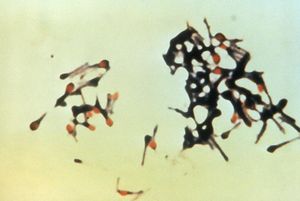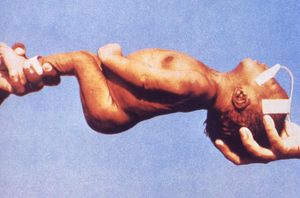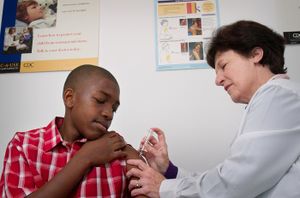Tetanus in sub-Saharan Africa: Difference between revisions
No edit summary |
No edit summary |
||
| Line 3: | Line 3: | ||
Image = Tetanos.jpg | | Image = Tetanos.jpg | | ||
Caption = Disease Incident World Map | | Caption = Disease Incident World Map | | ||
}} | |||
}} | }} | ||
Revision as of 08:52, 26 August 2009
Template:DiseaseDisorder infobox }}
Introduction
Tetanus is a disease caused by the bacterium Clostridum tetani. The disease is caused by a neurotoxin release by the bacterium once inside the host, and causes deadly spastic paralysis. The neurotoxin is the second strongest toxin known to man, only second to the closely related Clostridum botulinum. With immunization from the tetanus toxoid, the disease is completely preventable, however the WHO estimates up too 290,000 deaths each year, with 128,000 infant mortalities due to neonatal tetanus. In fact the WHO reports it as the second leading cause of death form vaccine preventable disease. [4],[7].
Description of Microbe
Lineage( abbreviated ) Bacteria; Firmicutes; Clostridia; Clostridiales; Clostridiaceae; Clostridium [1]

Structure and Function
Colstridum tetani are rod shaped bacilli, anaerobic fermenting, gram positive bacteria of the Clostridium genus. C. tetani are spore forming bacteria which form spores at their terminal ends, this gives them a tennis racquet like apprearance during sporulation [2]. C.tetani habituate low oxygen places such as soil, and animal instestine.[4] C. tetani are the cause of the disease Tetanus, which is caused by toxigenic species which carry the toxin producing gene on a plasmid. The two species have been found to be most susceptible to Tetanus neurotoxin are horses and humans. Tetanospamin is the toxin produced by these toxigenic species, but non toxic producing species have been found to exist. Most species of C. tetani are motile and form peritrichous flagella, in addition swarming is observed in some species. Other species are not immotile and do not form flagella [2]. C. tetani is not the only species in the Clostridium genus that produces endotoxins which are medically important neurotoxins, notably C. botulinum which produces botulism toxin. [3]
Genome
The genome of toxigenic C.tetani E88 a contains a chromosome with 2,799,250-bp and a 28.6% G+C content. However the plasmid (pE88) containing the toxin gene (tetX) contains 74,082-bp and a much lower 24.5% G+C content. The plasmid also contains the regulator for the toxin gene. Both the regulator and the toxin gene show homology to botulinum neurotoxins and regulator. Unlike many other enteropathogens the genome of C.Tetani, however has a very stable G+C content and not many transposable elements are found, evidence for lack of lateral transfer and genome stability. Some mobile elements are found on the plasmid however, including genes for transposase. The plasmid also contributes several other virulence factors, such a gene for collaginase, which may destroy host tissue integrity. The origin of the plasmid containing the toxin gene has yet to be revealed. It is not what enviormental signals turn on TeTx genes, or what regulates the activation of toxin transcription, however it is though that alternative sigma factors may be responsible. [4].
Bioenergetics
During their vegetate state C.tetani are anerobic and can not survive in the presence of oxygen, and use fermentation as their energy source. C.tetani are peptolytic, and prefer to use ammino acids and protein substances for fermations, however they have been shown to be able to grow on glucose, but not on polypeptides. C.Tetani excretes many exopeptidase to break down the proteins in the host tissue and then imports the peptides into the cytosol, using a sodium ion symporter.Unlike some bacteria which use a proton motive force, C.Tetani uses ATP as product of fermentation to establish an ion motive force by pumping out sodium ions via V-type ATPase. Sodium dependent systems are common among some thermophiles and other pathogenic bacteria. The influx of sodium is coupled to drive several transportation processes, some of which include multi-drug resistant exporters. [4]
Description of Disease
Pathophysiology
Transmission of disease
How is it transmitted? Is there a vector (animal/insect)?
Clinical Treatment and Vaccinations
Why is this disease prevalent in sub-Sahara Africa?

Since maternal and neonatal tetanus cases are prevalent in poor, developing communities, many newborns die due to poor access to good healthcare. Furthermore, people in major developing countries, such as people in Sub-Saharan Africa, may not receive the most promising vaccination coverage or immunization. Most women of childbearing age in the developing country are not even provided with immunization with tetanus toxoid, which immunizes women of childbearing age in order to enhance transfer of tetanus antibodies into their systems and protecting their newborns from catching neonatal tetanus. [5]
Tetanus is most common in hot, damp climates with soil rich in organic matter for spores to grow. This explains why Sub-Saharan Africa is such a prominent country for neonatal tetanus. Exposure to the spores of the bacterium, Clostridium tetani, is caused by the potent neurotoxin produced during the growth of bacteria in an anaerobic environment. Once the bacterium proliferates into the dead tissues, it releases toxins for spore germination as soon as the bacteria lyses. The toxin that was previously introduced to the body or synthesized as an inactive polypeptide chain during bacterial growth phage, is then transformed by bacterial or tissues proteases into its active form. [6] Tetanus spores, unfortunately, cannot be removed from the environment, causing tetanus to be spread through spores that were exposed to the intestines and feces of various animals. Spores can also be launched into the body through puncture wounds that have already been contaminated by the soil, animal waste, or any nature of debris.
Neonatal tetanus, the most common tetanus in the developing world, is the result of contamination of the umbilical stump by the usage of non-sterile instruments or animal dung to cut the cord after delivery. Many newborn deliveries are performed at homes by untrained birth attendants. Most people in Sub-Sahara African do not have a profound understanding of dangerous causes of neonatal tetanus on their children.[5] In fact, neonatal tetanus is a huge problem in Sub-Sahara Africa because of the lack of maternal and paternal education, the unavailability of effective contraception, improper hygienic deliveries and cord care. Large numbers of Sub-Saharan Africa physicians leave their homeland to practice medicine or upon completion of their medical school practices in search of expanding their work experience in higher-income countries. This leaves many Africans in distress of receiving proper healthcare systems. In Sub-Saharan Africa, life expectancy is only 50 years with about less than 32% of the deliveries are attended by trained personnel. People in Sub-Saharan Africa suffer from poor health systems, which greatly hinder the country from taking a huge step towards improving their infrastructures of healthcare and eliminating diseases.
What is being done to address this problem

Include anything being done by the local government or groups as well as efforts by non-local groups.
What else could be done to address this problem
Are there solutions that could be successful but haven't been implemented due to political or economic reasons? Are there successful efforts in other countries? Are there reasons why these efforts may or may not be successful in the country you've focused on? etc. etc.
References
1.) NCBI taxonomy
7.) World Health Organization. Vaccine-Preventable Diseases. "Tetanus". http://www.who.int. WHO 2009.
Images courtesy of Center for Control and Disease Prevention. Public Health Image Library (PHIL).
Edited by Freyr Petursson, Megan Glasheen, Meghan Wu, Chris Fascenda, David Cervantes, Lisa Sugimori, students of Rachel Larsen
This template is just a general guideline of how to design your site. You are not restricted to this format, so feel free to make changes to the headings and subheadings and to add or remove sections as appropriate.
